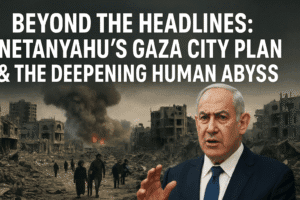Beyond the Headlines: Netanyahu’s Gaza City Plan & the Deepening Human Abyss
Netanyahu defiantly pushes forward with plans to seize Gaza City and displace its population, dismissing widespread condemnation and evidence of famine as “malignant lies.” His vague proposal for “safe zones” offers no practical solutions for moving 2 million traumatized civilians amidst collapsed infrastructure and starvation. The offensive faces fierce domestic backlash from families of remaining hostages, who warn it endangers captives and soldiers. Internationally, allies like Germany halt arms exports while European and Arab states condemn the plan as catastrophic.
Crucially, Netanyahu’s claim of seeking a “free” Gaza under Israeli security control clashes with his far-right coalition’s demands for annexation and permanent displacement. This escalation represents a grim calculus prioritizing military control over urgent humanitarian needs and hostage lives, deepening an already unimaginable human tragedy with no credible political resolution in sight.

Beyond the Headlines: Netanyahu’s Gaza City Plan & the Deepening Human Abyss
Israeli Prime Minister Benjamin Netanyahu’s defiant defense of a plan to seize control of Gaza City and effectively the entire Gaza Strip marks a dangerous escalation, met not only with global condemnation but profound human suffering and complex internal divisions. Here’s a deeper look beyond the announcement:
The Plan & Its Contradictions:
- “Clearing” Gaza City & Central Gaza: Netanyahu confirmed the forced displacement of civilians from these densely populated areas, claiming “safe zones” with ample supplies would be established. However, critical details are absent: Where are these zones? How will 2 million traumatized people, many already displaced multiple times, move “safely” amidst ongoing bombardment and destroyed infrastructure? Past displacement orders led to chaotic, deadly exoduses.
- “Freeing Gaza from Hamas”: Netanyahu insists the goal is not occupation but liberation, proposing a vague future with a “non-Israeli peaceful civil administration” under Israeli security control. This vision immediately collides with reality: His own far-right coalition includes ministers openly advocating annexation, permanent displacement, and halting all aid. The lack of a credible alternative governance structure remains a critical flaw.
- Dismissing Famine & Starvation: Standing before images of malnourished Gazan children labeled “fake,” Netanyahu called reports of starvation “malignant lies.” This stance contradicts overwhelming evidence from the UN, famine experts, international NGOs, and physicians on the ground, including NPR’s own reporting confirming severe malnutrition and deaths.
The Mounting Human Toll & Resistance:
- “Starve or Leave” Reality: Gaza City residents like Saady Barakat (60) express a desperate choice: “I will end up on the street or in a tent. No, I’d rather die here more dignified than dying on the street.” This sentiment reflects the utter lack of trust in Israeli assurances and the destruction of viable alternatives. The UN states the humanitarian system has “effectively collapsed,” with hospitals unprotected and supplies critically restricted.
- Hostage Families’ Anguish: The families of the remaining 50 hostages (20 believed alive) vehemently oppose the offensive. They argue expanded fighting endangers captives and soldiers, demanding the government prioritize a ceasefire and hostage deal. Former hostages joined protests, amplifying the message that this plan risks the very lives Netanyahu vowed to save on October 7th.
- Palestinian & International Outcry: Palestinian Authority President Mahmoud Abbas condemned it as “a complete crime” and “genocide.” European nations (Spain, Portugal, Norway, etc.) warned it would worsen the crisis and cause “an unacceptable high toll of deaths.” Germany halted military exports usable in Gaza. Saudi Arabia, Jordan, Turkey, and the UK joined the chorus of condemnation at the UN Security Council.
The Geopolitical Chasm:
- US Position: While critical of aspects of the war, US Ambassador Dorothy Shea stated, “Israel has a right to decide what is necessary for its security,” placing the onus solely on Hamas: “this war could end today if Hamas would let the hostages and all of Gaza go free.” This stance provides crucial diplomatic cover despite mounting humanitarian concerns.
- Netanyahu’s Call to Trump: The Prime Minister’s reported call to former President Trump, thanking him for “steadfast support,” and Trump’s prior comment that Gaza’s fate is “pretty much up to Israel,” highlights the domestic US political dimension influencing the conflict.
The Unanswered Questions & Deepening Crisis: Netanyahu frames the seizure of Gaza City as the “best way to end the war speedily.” Yet, the plan raises profound, unresolved issues:
- Humanitarian Catastrophe: How can mass displacement not exacerbate the famine and collapse of medical care documented by the UN? Where is the concrete, internationally verifiable plan for sustaining life in these “safe zones”?
- Hostage Fate: Does escalating military pressure truly increase the chances of freeing hostages alive, or does it make Hamas less likely to deal and put captives in greater crossfire danger?
- Future Governance: Who will constitute the “peaceful civil administration”? How can it function under Israeli “overriding security control” without being seen as a puppet entity, lacking legitimacy among Palestinians?
- Regional Stability: Will further escalation and potential mass casualties ignite wider conflict, drawing in regional actors already inflamed by the staggering death toll (over 61,000 reported by Gaza Health Ministry)?
Netanyahu’s plan represents not a resolution, but a perilous gamble. It prioritizes a decisive military outcome over immediate humanitarian imperatives and hostage lives, dismisses documented suffering, and offers no credible political horizon. The widening gulf between Israeli government actions, international law and outcry, and the desperate reality for 2 million Gazans signals a deepening abyss with consequences far beyond Gaza’s borders. The world watches, largely powerless, as civilians pay the ultimate price for a strategy built on displacement and denial.
You must be logged in to post a comment.